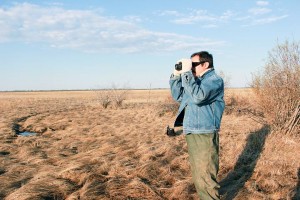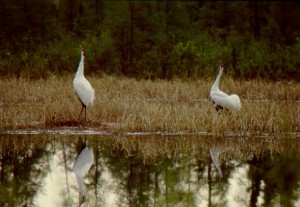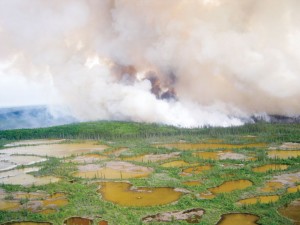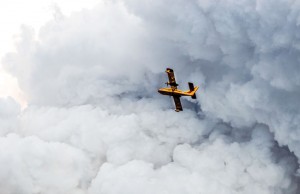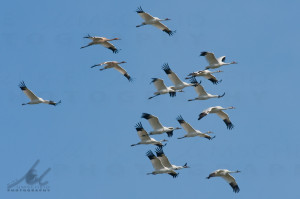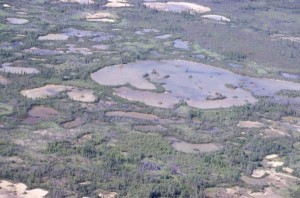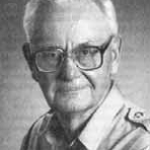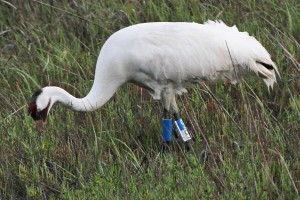Archive for the ‘Wood Buffalo Updates’ Category
Biologists wrap up annual WBNP whooping crane studies
September 4, 2014The Canadian Wildlife Service reports that at least 32 whooping cranes have fledged in Wood Buffalo National Park and surrounding area in 2014.
For more detail please see the article in the Northern Journal
WANTED
The Whooping Crane Conservation Association is currently seeking interested people to fill upcoming vacancies on our Executive. All executive positions, including those of the Trustees, are volunteer positions with no remuneration.
Secretary
We are seeking a person with organizational skills who is interested in becoming the secretary of the WCCA. The secretary is reponsible for keeping track of the membership information and donations. Proficiency with Microsoft ACCESS an asset.
Newsletter Editor
We are seeking a person with writing and organizational skills to put together our newsletter “Grus Americana”. The editor assembles articles of significance and then uses word processing software to form a newsletter. Proficiency with Microsoft Word or other word processing software an asset.
If you are interested in either of these positions, please use the Contact WCCA page. Thanks for your interest.
Number of whooping cranes rising in the N.W.T.
August 8, 2014The world’s number of whooping cranes are steadily on the rise, according to biologists at Wood Buffalo National Park.
There are now an estimated 300 cranes in the flock, which is up from 16 in the 1950s.
Read the full story on the CBC News Website
Record-breaking number of nests counted
June 11, 2014Record number of Whooping Crane nests in Wood Buffalo National Park and surrounding area. Recent surveys conducted by the Canadian Wildlife Service on the whooping crane breeding grounds have revealed 82 nesting pairs.
Read the full story on the Northern Journal website
Fort Smith man stands on guard for whooping cranes – Canadian Wildlife notes whoopers expanding nesting range
June 25, 2013by Renée Francoeur, Reporter, The Northern Journal, Fort Smith, NT, Canada
His mission – completely voluntary – is to watch over the tallest birds in North America, the whooping cranes, which nest in the area after a 2,500-mile summer migration from Texas.
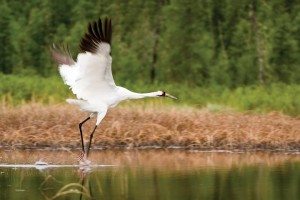
Photo by Photo: Klaus Nigge – An elegant whooping crane swoops across a wetland.
“They’re my passion and I want to help protect them. You can’t see this anywhere else,” said Schaefer, a town bylaw officer and Salt River First Nation councillor.
Canada is home to the world’s largest migratory population of whooping cranes. According to Environment Canada, there are almost 300 birds in the Wood Buffalo flock – the only self-sustaining, wild flock on earth.
Whooping cranes were designated as endangered in Canada in the year 2000. It was estimated by the Whooping Crane Conservation Association that only 16 whooping cranes were left on the entire planet in 1941-1942.
“I was probably 14 when I saw my first whooper. I was out hunting birds at Foxholes. When I came to realize these were endangered birds, I just wanted to take care of them,” Schaefer said. “I want to share what I know and see with others so we can come together to help preserve their habitat.”
Schaefer has named the two young cranes he’s been keeping an eye on Snowball and Snowflake, who he thinks are descendents of the original “Lobstick pair,” which still nest further down on the Foxholes prairie land.
Canadian Wildlife counts 74 nests in 2013
Many cranes make their nests in the traditional breeding grounds in the northeastern corner of Wood Buffalo National Park. Their nests are counted every year for a survey by the Canadian Wildlife Service, undertaken in partnership with Environment Canada and Parks Canada.This year, 74 nests were counted, according to Mark Bidwell, a species at risk biologist with Environment Canada. That number is one less than the record set in 2011 at 75.
“Counting the nests gives us an idea of how the birds are doing and it helps us track their movement,” he told The Journal. “The number of nests goes up and down from year to year, but over long periods of time, it’s continuing to tick upwards. That’s a positive.”
Bidwell estimates about 150 birds are breeding out of the 300 in the flock.
As well, Bidwell noted, the population continues to expand outside the park. Eight nests were discovered outside Wood Buffalo’s perimeters this year – one more than ever recorded. Additionally, breeding pairs, known to go back to the same nest year after year, are making nests in new locations, never before monitored by surveyists. Four to six new nests were recorded this year.
“What this means is the population is moving increasingly into areas that are not formally protected. It’s not a critical situation yet as most birds are still using the park and the ones using areas outside the park, those locations are still quite remote. In Texas, however, where they spend the winter, it’s different and they are coming into more contact with people and development.”
More possibilities of human interaction with the cranes also worries Schaefer.
“Almost every long weekend there are people out quadding in this nesting area at Foxholes,” he said. “On the May long weekend, a big group was headed right for the nest and if I hadn’t been here to stop them, they’d most likely have run right over it…There’s this perception, you can go quad anywhere. You can’t. This is a restricted area. I put big ‘Whooper Warning’ signs up to keep people away from them, but it doesn’t seem to be working.”
Sonia Trudeau, who went out with Schaefer to see the cranes last month, said she cried when she saw the eggs.
“That is something no one gets to ever see. It’s so special. I’ve lived here in Smith all my life and never seen that,” she said. “More people need to be aware of where the nests are. We need to protect them and their habitat or they won’t be here one day.”
The Canadian Wildlife Service will return to the Fort Smith area in August to do a follow up survey on the nesting success and chick productivity.
“Typically, 40 to 50 per cent of the nests we found in May will have chicks survive. That’s not as bad as it sounds for a big-bodied bird who can live up to 20 years,” Bidwell said. “While most pairs lay two eggs, usually only one chick survives. Sometimes there are both, though, depending on the year and resources.”
Meanwhile, Schaefer said he plans to keep a close eye on Snowflake and Snowball’s rusty-brown coloured chick, who just hatched last week.
“They know me. I can read them. I know when to back off when they’re in protective mode. I think they know I’m looking out for them,” he said.
Whooping Crane Nesting Going Great
June 19, 2013by Chester McConnell, WCCA
A Canadian citizen whooping crane observer told the Whooping Crane Conservation Association that 74 nests have been counted in Wood Buffalo National Park this year (2013). Some of the nest have already hatched and the whooping crane parents are making their unison calls as shown in the photograph. The Association is hoping for a very successful reproduction this year. Note the young whooping crane chick in the photograph.
Photograph by Brian Johns, President, Whooping Crane conservation Association
Salt Mountain burns as Mother Nature has her way
June 18, 2013by Don Jaque – Northern Journal, Fort Smith, Canada— June 10, 2013 at 6:32 PM
Photo: ENR NWT – The fire on top of Salt Mountain approximately 30 km west of Fort Smith grows to 1,100 hectares on Wednesday evening due to a cold cell and gusting winds that sent embers across the highway out of Wood Buffalo National Park.
For the second time in less than 11 months, a major campaign fire on Salt Mountain within 35 km of Fort Smith brought that community to a high state of alert, followed by relief after it was expertly controlled.
Last summer in late July, a multi-jurisdictional fire that started in Wood Buffalo National Park involved Alberta, NWT and national park resources in a campaign fire pushed by wind. Fire crews managed to corral it just as it threatened to cross Hwy 5 and take out the power lines from Taltson Dam that serve Fort Resolution, Enterprise and Hay River and potentially even turn towards Fort Smith. The fire was contained right at the highway with textbook-like precision.
The current fire started June 1 due to lightning in the park, burning slightly southwest of the 2012 burn, just south of Hwy 5. Over several days, Parks Canada crews from Wood Buffalo and three other national parks worked the fire on the ground, assisted by choppers with buckets and tankers of retardant from Alberta and the NWT.
On the night of June 3, the fire grew dramatically overnight. Crews performed a successful burnout operation along the highway to clean out fuels it might feed on if it turned that way to cut off the road and even burn the power lines. It was well contained and under control at that point.
Mother Nature decided to trump all that, however. On June 5, the weather changed and a cold front moved in, generating high winds from the south. By the afternoon, the fire had jumped the highway.
Photo: Patrick Pennycook – A GNWT water bomber heads through a thick cloud of smoke during control efforts on Wednesday evening.
“A spot inside the fire flared up and embers travelled across Hwy 5,” commented Jean Morin, fire program manager for Wood Buffalo National Park. He said the embers flew nearly a kilometre from well inside the fire, over the burnout, and started a new fire on the north side of the highway. It moved quickly.
“With the wind, the spread of the fire was very fast,” Morin said.
He said they bucketed the fire with the Parks Canada choppers and the NWT government called in air tankers to lay down retardant. The fire got into pine and spruce forest along the road to the Foxholes Prairies, producing a massive smoke column in the afternoon sky.
The fire then became an NWT challenge and crews from Fort Providence, Fort Liard, Inuvik and Hay River joined Fort Smith crews on the ground and hit it hard. Retardant lines were laid down by air tankers to protect the nearby settlement of Salt River. Five bulldozers were contracted to create a fire guard that protected both Salt River and the Foxholes Prairies where several pair of whooping cranes nest.
In the middle of the rampaging wildfire was an encampment of heavy equipment belonging to Aurora College, sitting in a gravel quarry near the Foxholes road where the college runs on-site training for a Thebacha Campus Heavy Equipment Operator course. College staff were forced to abandon the work site as soon as news came of the fast moving fire. There was fear all that expensive equipment might be lost.
Fortunately, all equipment survived unscathed. The Caterpillar tractors, loader and excavator were parked in the centre of a large gravel pit and the fire burned around and past it.
Cool weather subsequently helped the firefighters’ cause and with rain June 6, the blaze, after six action-packed days, was finally brought under control.
Whooping Cranes Migrating to Wood Buffalo, Canada
May 21, 2013The Aransas/Wood Buffalo whooping crane flock is well on its way to Canada’s nesting grounds. Approximately 285 whoopers are involved in the 2,500 mile migration. Traveling in small groups the whoopers are expected to begin arriving at the Wood Buffalo National Park nesting grounds in Canada soon according to the Whooping Crane Conservation Association.
Dr. Wade Harrell, U.S. Whooping Crane Recovery Coordinator advised that most of the whoopers have departed from their wintering grounds at Aransas National Wildlife Refuge in Texas. Over 30 are currently being tracked via GPS telemetry so wildlife biologists can monitor their movements and learn more about the areas they visit during migration. By May 5 most of the birds had left the wintering grounds. Some have reached Canada.Three cranes with GPS radios are still in North Dakota as of May 21.
To keep up with the migration click on the following link https://whoopingcrane.com/migration/ .
Mark Bidwell, Species at Risk Biologist, Canadian Wildlife Service is currently at Wood Buffalo nesting grounds to begin the spring survey. Conditions on the nesting grounds and arrival of the whooping cranes will be monitored for the next several weeks. A report on Bidwell’s findings during his surveys should be available in the near future.
Whooper Nesting Grounds Located (History)
January 2, 2013****History Briefs compiled by Whooping Crane Conservation Association****
Editor Note: For many years no one knew exactly where whooping cranes nested. Until 1954 whooping crane interests only knew that the birds migrated from “somewhere” in Canada to the Texas Coast. Crane interests had watched as the whooper population declined to 16 individuals in 1941. Pressures were brought on government agencies to protect and manage the birds. It was important to locate the whooper nesting habitats so these essential areas could be protected. In 1954 the whooping crane nesting area was finally located. The story is an interesting part of history. Whooping Crane Conservation Association member Pam Bates researched the literature and came across an article published in “Wild Lands Advocate” that tells the story. This is a follow-up to another article on our web page published on December 23, 2012. Click on the following link for the related story: https://whoopingcrane.com/whooping-cranes-from-despair-to-hope-to-progress/
DISCOVERY OF THE NESTING GROUND OF THE WHOOPING CRANE *
by Dr. W. A. Fuller
I have received a lot of credit for the discovery in 1954 of the only whooping cranes in Canada, but if it hadn’t been for the fire and an observant forester named George Wilson, I might never have gone out to identify the birds. The last nest of a whooping
crane had been seen in about 1926 in Saskatchewan. Members of the U.S. Fish and Wildlife Service (USWS) and others had searched from central Saskatchewan to the delta of the Mackenzie River without success. The USWS was interested because whoopers migrated to Texas.In 1945 I spent the summer working on fish in Lake Athabasca. At the end of the summer I decided that I would never return to the north. However, in 1946 I signed up to spend the summer at Great Slave Lake. The following winter I put together all the data that had been gathered over several years on the “Inconnu” (Stenodus leucichthys) and submitted the result as my masters thesis for the University of Saskatchewan. Convocation took place in early May.
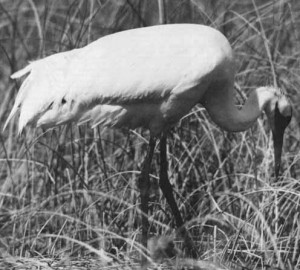
Whooping crane. (From a 1982 Hinterland Who’s Who brochure on the Whooping Crane written by E. Kuyt and published by the Canadian Wildlife Service)
A few days after the ceremony, I turned 23, and on the last day of May I married the young lady who is still my wife. I had previously applied for one of two jobs advertised by the federal government, and I was approved for the one based in Fort Smith, NWT. I found the north gets under your skin, and my wife Marie and I landed in Fort Smith on June 5. My duties centred on mammals in the south half of the Mackenzie District and in Wood Buffalo National Park (WBNP), part of which is in Alberta.In those days, the United States sent a bird guy, Bob Smith, and an assistant down to the Arctic Ocean. They flew out of Fort Smith for two or three days, and I usually took them up on their invitations to go on their sorties. Bob was a great guy, as well as a good pilot and a good bird man. Although waterfowl were the main target, they kept their eyes open for other birds, such as whooping cranes. As late as 1954 they had not made a sure discovery of whoopers, although on an earlier flight with them, one thought he had spotted a crane, but by the time Bob swung the plane around, whatever had been seen had disappeared.
In June 1954, a fire broke out in the northern part of Wood Buffalo Park. On June 30, the fire crew radioed to Fort Smith that one of their pumps was out of order. The forestry guy, George Wilson, went out to the site of the fire in a whirlybird piloted by Don Landells. I was in my office around 4:00 p.m. when a message came in from the plane to the effect that George and Don had seen a few big white birds, which they suspected were whooping cranes. Furthermore, Landells was to make another trip on the same route with a new pump, and if Bill Fuller was at the landing spot at 5:00 p.m he. could go back with Don and the pump.
Bill Fuller was at the landing and ready to go at 5:00 p.m. Don took us back on about the same route he had flown earlier, and we did see some large white birds, which were certainly whoopers. There were young birds as well as adults, so there was reason to believe that the nesting grounds were not too far away. I think we saw about nine birds on that first trip. I sent a telegram to the head office in Ottawa later that evening.
Ottawa’s reply the next morning asked me to keep an eye on the birds whenever there was a chance. I made several trips on an ordinary prop plane. On one such trip I counted thirteen birds, which was just over half of the birds (21, I think) counted in the Texas flock at that time.
The Whooping Crane Society and the USWS were very excited about the discovery, and soon there was talk about a ground survey in 1955. Canadian and American scientists would carry it out. However, the Canadian Wildlife Service (CWS) did not want to commit to that until there was proof of nesting, so I was to take a look next spring as early and as often as possible.
In those days, light aircraft landed on skis in winter and on pontoons in summer. The changeover was made in Edmonton in spring and fall, so it was difficult to find tansportation just when I needed it. While our government plane was in Edmonton, I got a ride with a pilot from Yellowknife on his way to Edmonton.I got another ride in a plane owned by the RCMP in Fort Smith. On that flight I saw what could only be a crane sitting on a nest. So the ground survey was on. Robert P. Allen of the National Audubon Society was to lead it. When Allen arrived in Fort Smith, we made one flight over the area so I could show him the location of the known nests.
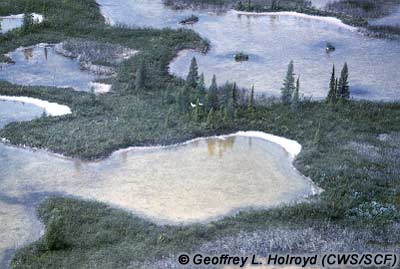
The nesting habitat of the Whooping Crane consists of marshes, shallow ponds, small creeks, and patches of wooded terrain and shrubs. Note two whooping cranes in the center of the photograph.
I made other flights, and I think I found a few more nest sites, but when the ground survey came on, I was at a conference in Alaska. The attempted ground survey is a story of its own.In 1956 I moved to Whitehorse in the Yukon, and Ernie Kuyt of the CWS took over work on the cranes. I had flown over the region of the first sightings a number of times. I had noted the tracks in the mud and searched my brains for a mammal that would make such a trail in the soft mud of the lake bottoms. Big birds never crossed my mind until I saw the cranes there in 1955.So who discovered the nesting ground? Wilson and Landells, who saw the big white birds? Me, because I saw young birds as well as mature birds on my sorties in 1955 and was also the first to see a female on a nest in the spring of 1956?It doesn’t really matter. The important point is that an important nesting ground was found. Each year for several more years, Ernie Kuyt found new nests. The total number of cranes in the Texas/WBNP flock has continued to increase in most, if not all, years since 1955.b
* Published in Wild Lands Advocate, The Alberta Wilderness Association, December 2004 • Vol.12, No. 6, pages 16 and 17.
Remote Tracking of Aransas-Wood Buffalo Whooping Cranes
April 10, 2012By: Aaron Pearse, USGS Northern Prairie Wildlife Research Center and Brad Strobel, USFWS, Aransas Wildlife Refuge
Since 2009, a partnership of agencies and organizations has been conducting research on the Aransas‐Wood Buffalo population of Whooping Cranes. Fundamental objectives of our research efforts are: 1) to advance knowledge of Whooping Crane breeding, wintering, and migratory ecology, including threats to survival and population persistence; 2) to disseminate research findings in reports, presentations, and peer‐reviewed literature to provide reliable scientific knowledge for conservation, management, and recovery of Whooping Cranes; and 3) to minimize negative effects of research activities to Whooping Cranes.
Funds and personnel in support of this endeavor are being contributed by the Canadian Wildlife Service, The Crane Trust, Plate River Recovery Implementation Program, U.S. Fish and Wildlife Service, U.S. Geological Survey, Parks Canada, International Crane Foundation, and Gulf Coast Bird Observatory.
To meet objectives, members of the partnership have captured and marked 35 Whooping Cranes. We captured one juvenile and two adults along the Gulf Coast of Texas during winters 2009 and 2010. Capture teams marked nine juveniles during August 2010 and 12 juveniles during August 2011 at Wood Buffalo National Park in Canada. In December 2011, we successfully captured and marked 11 cranes on Aransas National Wildlife Refuge, eight of which were known or suspected paired adults.
Capture teams consist of individuals with experience handling and marking endangered cranes. At capture, a licensed veterinarian performs a health check on each crane, which includes an external examination and screenings for pathogens, toxins, and parasites. We affix all captured cranes with a satellite transmitter (Platform Transmitting Terminal) with Global Positioning System capabilities mounted on a two‐piece leg band. The transmitter and leg band weigh approximately 72 g, which is <1.5% of body weight of adult cranes.
Integrated solar panels on all exposed surfaces allow transmitters to function for approximately three to five years. Transmitters record GPS locations every six hours, providing detailed information on nocturnal and diurnal site use and general flight paths.
Approximately every 56 hours, transmitters upload new data, which assists in identifying mortality events when possible.
We have been collecting location data on marked birds since December 2009 and expect data collection to continue for at least the next three years. As our sample of marked cranes has expanded in 2011, expectation among research partners has increased as we begin to explore the volume of rich information provided by marked individuals. Partners agree that this opportunity to mark wild Whooping Cranes with GPS technology represents an exceptional prospect to enhance our understanding of whooping Cranes and assess risks they face during their entire life cycle.
Article from The Unison Call, newsletter of the North American Crane Working Group
Whooping Crane Nesting Survey Locates a record 75 Nests
June 9, 2011Mark Bidwell, Whooping Crane Coordinator for the Canadian Wildlife Service reports that he and Kathy St. Laurent (CWS-Ontario) completed this year’s survey of nesting whooping cranes in and around Wood Buffalo National Park (WBNP) last week. Mark advised that, “We conducted the survey in close cooperation with Parks Canada (PCA) and were accompanied on one day by John McKinnon (PCA) who will also assist during the August survey. All in all, we flew 17.7 hours in a Bell 206 helicopter and 7.1 hours in a Cessna 210 fixed wing. In addition to surveying the usual nesting territories, we did some reconnaissance work in areas identified as potential habitat but that hadn’t been searched recently.”
Mark continued, “We’re pleased to report that we detected a record 75 nests, including a few in areas apparently being colonized by new nesting pairs. We made a number of changes, on scientific and safety grounds, to the way the survey is conducted so were happy to have good results despite the changes. We’ll revisit the nesting territories in August to assess productivity. We will also take colleagues from USGS, USFWS and ICF to mark an additional 10 to 12 birds as part of the ongoing telemetry study that aims to better understand the ecology of, and threats faced by, the Aransas-Wood Buffalo population.”
Tom Stehn, U.S. Fish and Wildlife Service added that, “The record of 75 nests found on the May surveys, surpasses by one the 74 nests found last year. Habitat conditions looked good, so hopes are high to have a good production season and an increase for the flock in 2011. With luck, a record 300 whooping cranes could make it to Aransas this fall!”
Mark Bidwell also pointed out that, “I appreciate the support for this year’s survey from CWS and Parks Canada, and hope to build on this cooperation in the coming months and years. Many thanks to Kathy St. Laurent and John McKinnon, and especially to Dave Duncan, Mark Wayland, Lesley Dunn, and Stu MacMillan who made their participation in this year’s survey possible.
